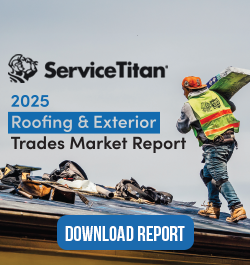Mark Huysken: The Importance of Balancing Ventilation - PODCAST TRANSCRIPT
February 22, 2024 at 12:00 p.m.Editor's note: The following is the transcript of a live interview with Mark Huysken of Quarrix. You can read the interview below or listen to the podcast.
Intro: Welcome to Roofing Road Trips with Heidi. Explore the roofing industry through the eyes of a long-term professional within the trade. Listen for insights, interviews and exciting news in the roofing industry today.
Heidi J. Ellsworth: Hello and welcome to another Roofing Road trips from RoofersCoffeeShop. My name is Heidi Ellsworth and one of the biggest topics in roofing today, ventilation. So we always like to get it out there, talk about this on this podcast because it's just so important. So we asked our friends from Quarrix to come in and really talk to us about what's happening with ventilation and what are some of the common mistakes that are being made. So I am thrilled to introduce and welcome Mark Huysken to the show. Mark, welcome.
Mark Huysken: Heidi, thank you. Yeah, good morning. Thanks for having me on. It's definitely a privilege to join you and to be a part of your great podcasts.
Heidi J. Ellsworth: Oh, I love it. We love having you. This is such an important topic. So let's start out with introductions. So if you could introduce yourself, tell us a little bit about what you do at Quarrix and tell us about Quarrix.
Mark Huysken: Yeah, absolutely. So me personally, I am a strategic account manager with Quarrix Building Products. I've been with Quarrix, well I'm in my fifth year with Quarrix. Under my responsibilities are our national accounts, as well as managing the Central United States sales. It's a great privilege to be part of the team, a great company. Prior to that, I spent about 18, 19 years in distribution with roofing and siding primarily in one step and two-step. I got my start on a conveyor truck slinging shingles and worked my way up into sales inside, outside,-
Heidi J. Ellsworth: I love it.
Mark Huysken: Branch management. I've done it all. Spent a lot of time. This time of year, a lot of guys are doing inventory and I feel their pain and I'm glad I don't have to do that anymore, but.
Heidi J. Ellsworth: Oh my gosh.
Mark Huysken: Never a fun time. But yeah, so Quarrix Building Products, we are just a great company based out of Minneapolis, Minnesota. Real quick. We're part of a larger company, Liberty Diversified International based out of Minneapolis. We're a third generation owned, privately held. We do a lot of different things. Our major components are actually paper and cardboard and boxes, and we have a furniture company and then we have a plastics, custom plastic company.
Heidi J. Ellsworth: Wow.
Mark Huysken: And Quarrix is part of that custom plastics company and just been a great joy to be with them for the last four or five years. I worked with a great team of people and I count it a privilege to work with them every day.
Heidi J. Ellsworth: That's great. That's great. And in today's world, to be privately held, that's still something out there because with all the things that, consolidation that's going on, but I really wanted to talk about the growing awareness of ventilation. I mean, I've been in the industry close to 30 years and ventilation has always been important, but I don't think it's ever been as important as it is today or talked about as much as it is today. Can you kind of tell us why you think we have that growing awareness for ventilation in the industry?
Mark Huysken: Yeah, absolutely. I think there's a number of reasons, Heidi, and I think a big part of it is the building envelope is just getting tighter and tighter, and that's not a bad thing. It's a good thing to seal up the houses better. But what's happened is we're sealing up the roof decks, we're sealing up the walls and suddenly the exterior products are screaming basically for help because there used to be breathing through the walls and breathing through the roof deck, and now we're putting on really great synthetics and ice and waters, and the quality of shingles keeps improving. They seal better and tighter, so no longer is their breathing through the roof deck and breathing through the wall, and the house is just sealed up tight, almost like you put it in a Ziplock bag and zip it shut. It's just such a tight envelope, which is great for efficiencies.
But now I think we suddenly realized in the industry that we've got to respond to that and we've got to let the walls breathe and let the attics breathe, and it's catching up to us pretty quick. And then another thing that's worth mentioning is the cost of shingles. The cost of roofing. When I got into the industry, a bundle of shingles was like 12 bucks. Right. And now I've heard basic shingle prices probably three, four, five times that. So when you think of, if somebody goes in and does a re-roof and the roof just doesn't last like it's supposed to because of a ventilation issue, it costs a lot more money to replace that roof today than it did 10, 20, 30 years ago.
And plus, as we seal up that house tighter, we're also holding in moisture. And that moisture in the attic is bad. I mean, you're going to see mold growth, you're going to see your insulation in the attic kind of get depressed, wet and damp and it's just going to not ventilate properly. It can be unhealthy to us as residents of the home, and it can be certainly unhealthy to the home and absolutely not going to, you take a lifetime shingle and it's just not going to last a lifetime anymore without good ventilation.
Heidi J. Ellsworth: Yeah, exactly. And I mean all those points are so key and it has changed so much over the last couple decades and kudos to the manufacturers for also really kind of promoting that and putting it out there. I know it's hard for somebody to think my warranty is going to be void, but it makes people really look at how important this is. But in that, as people are really looking at putting the ventilation, I know there are some common mistakes that are made that you actually, through your travels and all your different seminars have really been able to put together. Can you talk to us about that?
Mark Huysken: Yeah, absolutely. I get the privilege of training both roofers, contractors and sales teams and management teams all across the country on ventilation. And we have some great conversations. The best trainings are the ones that go long because there's lots of questions, lots of interaction, but I would say almost every training I do, I see roofers kind of get an aha moment. And the aha moment is tied to the intake. And the reason it's tied to the intake is because for so many years as a roofing industry, we've been talking about ventilation exhaust, ventilation exhaust, because that's what the roofers are typically doing. They're going on the roof and doing a great job of doing a re-roof, and they're putting on some sort of exhaust ventilation, but they're not matching it to the intake. They're not even necessarily looking at the intake because we haven't trained them about that.
And now we start talking about the intake needs, which is really a lot of guys go, well, that's the sider, or that was already there. What am I supposed to do If it's already existing, how do I overcome that? And those are some of those, again, those aha moments where guys are going, oh, okay, so I'm making a mistake by just opening up the exhaust without taking a look at the intake. It's so critical to look at both.
Heidi J. Ellsworth: Yeah. Wow. Wow. Okay. And so that's really kind of where we're talking about, that balanced ventilation system, and that's where you are really trying to help them. So what do the contractors do to make sure they get that balanced system?
Mark Huysken: Yeah, no, that's a great question. The thing that a lot of contractors, I think, and they've got great intentions, but I just don't think they're taking a step back to look at the intake. And I think it's important that they do that. They have to assess the situation. Part of that means going into the attic and looking at the intake and seeing if it's wide open. There may be existing intake on the overhangs in the eaves, there may be some great vetted soffit, but maybe it's all plugged up or maybe it was good ventilation 20 years ago, but it's been painted over 10 times and since then the insulation's been blown around. Maybe there's no attic chutes holding the insulation, the blown insulation back. So they have to step back and assess the intake and really do the math on the intake. And it's hard sometimes because you're looking at an intake system sometimes that's 25 old, and you can't just look it up. The homeowner doesn't have an NFA number, they don't know the airflow of it.
So you have to make some good educated guesses. I'm spending a lot of my ventilation trainings now talking about that, how to assess that situation and how to balance it. Because without balance, the system fails miserably. Building codes call for balance. Every single manufacturer, every vent manufacturer asks for balance now. I mean, it's an industry standard. It's not something unique to Quarrix at all. It's really the industry standard, balance. And the unbalance actually is allowed only when you have more intake and less exhaust in a 60%, 40% split, but you can't exceed your intake with your exhaust. You're going to have just failures at that point. Really bad failures. Where you see the failures especially is, it’s more evident in Northern climates.
So I live in Michigan and I've been in Michigan all my life and in the industry, and every winter we would get phone calls when I worked at the branch level, and even today I talked to contractors who get snow in the attic. Snow is very evident of a failing ventilation system. And usually what that means is that there's too much exhaust and not of intake. So what happens is the snow, that snow globe, light snow that's just floating around in the air, kind of whirling around, that gets sucked into the exhaust vent. Well, the exhaust vent's not designed to be a sucker, right? It's designed to be an exhauster. It needs to exhaust the air. But what happens in climates when there's not that light snow, we just don't see it. That light snow is what tips us off to it.
But if there's never a snow climate or if you just never have that light snow, you could go years not realizing that your exhaust is actually pulling air in and you're not getting the turnover in the attic that you need to get. You're not getting the ventilation in the attic, or you're not getting the intake at the intake point and the exhaust point, you're not reducing the temperature, you're not reducing the humidity and at that point, it's just not doing you any good. Again, with roofers, they have the best intentions in the world, but they oftentimes, they'll take a ridge vent, for example, and they'll open up every foot of ridge that they possibly can. They'll maximize the exhaust. See, a big mistake in the industry is bigger is better, more is needed.
I get calls from contractors, from homeowners who will say, oh, my attic's really hot, so I'm going to have this contract come out and put on more vents. And I go, hang on. First of all, let's not mix the ventilation, number one. And number two, if your attic is hot and you feel you need more vents, you need to step back and look at the intake because if the intake is not there, you can keep putting exhaust vents on all day long and all that's going to happen is you're going to get swirling around the top of your roof as the air jumps from one exhaust vent to the other exhaust vent. But everything below that is just stagnant. Nothing's happening at all.
Heidi J. Ellsworth: And I mean, you just have totally taken away your energy savings. Obviously, it gives a prime environment to grow mold and other problems. And so yeah, that makes so much sense.
Mark Huysken: Absolutely. Absolutely.
Heidi J. Ellsworth: Okay. I want to kind of switch from the, yeah.
Mark Huysken: Go ahead.
Heidi J. Ellsworth: Okay. I want to switch a little bit from the roofing contractor to the builder. So when we're looking at the builder, a lot of this starts when the homes are built and the roofing contractors just kind of inherit that. So what should builders keep in mind as they are putting this together to make sure that they have the necessary components for the right systems?
Mark Huysken: Yeah, absolutely. They need to step back and look at the balance and it's an unfortunate situation for the roofer because the roofer is the last guy to touch it, the last guy or gal to touch that roof or the house sometimes on exterior. And for the most part, and what happens is they get blamed. They get blamed because the attic's not breathing. But it really comes back to the design of the house. So when you have a new construction house, you need to take a step back and do the math. It's not hard. A big part of my ventilation trainings and to me the most critical component, I tell guys when I'm training them, this is the most important part. If you don't pay attention to anything else, pay attention to this. And we go through a ventilation audit and I teach them how to analyze the needs for the exhaust.
And then when we're done analyzing the needs for the exhaust, we take a step back and we examine the existing intake. And sometimes that existing intake is a brand new home, sometimes it's not. I was working with a new construction builder recently, and they were building these eight wide duplexes or condos. So there were eight units in a row, and they were only 24 feet wide. And the fire laws required that you couldn't open up the attic or the soffit within five feet of the adjoining unit. So when you have 24 feet wide and you have to come in five feet on both sides of an eight plex, you have 10 feet for intake and 10 feet for exhaust. And then building codes in that region called for one square foot of ventilation for every 150 square foot of attic. It was impossible. It was a truly impossible situation to hit the one to 150.
But I try to work with, when we've talked to contractors or builders, especially new construction builders, we try to help them identify those areas and try to solve the problem. And building codes basically call for, for example, most of the country calls for one to 150 rule, one square foot of ventilation for every 150 square feet of attic. And that one square foot of ventilation is divided 50, 50 between intake and exhaust. And then building codes also say balance. So sometimes you have to pick the lesser of the two evils just because of what you have available, and it's truly not actually meeting the building code requirements. But if you can at least hit that balance, I think you're better off than nothing.
And I definitely put more emphasis on balance than anything else. When I talk about balance, I oftentimes use straws as an example. So you get straws like this in a cocktail and they're always the same size at both end. Right. Or if you get a Coke, you might get a straw like this, same size at both end. Right. You get a smoothie, you'll get a big fat straw like that, right, but they're always the same size at both end. Could you imagine trying to drink out of a funnel? I mean, and I'm not talking like a college funnel, that's a different drink, but you can't drink out of a funnel and your attic's the same way, it can't breathe with a funnel. It has to be equal, the top and the bottom, and it's just that simple, but it's that complicated because most roofs are not like that.
Heidi J. Ellsworth: So that balance makes so much sense. Mark, I totally get it. I love the straw example. That is so cool. As builders and then roofing contractors are looking at this, they definitely need the balance, you know the components, intake, outtake, but what are some of the other factors that they should be aware of for the building? What are some other things that they should be thinking about?
Mark Huysken: I think placement is important when they're looking at their ventilation. Sometimes there's not a lot of thought of placement. And what I mean by that is when we analyze the need for, let's just say we're using ridge vent, let's say there's 100 feet of ridge, but when we do the math and we realize we only need to open up 60 feet of ridge. So we have 100 available. To get that one to 150 rule, and to balance it with the intake, we only need to open up 60. We need to then stagger that opening, stagger that 60 feet, maybe open up five and close two, just kind of stagger it basically. There's no perfect science to it. Just don't throw that 60 right in the middle. We want to stagger it.
And this is a hard thing for roofing contractors to understand, is to not open it all. And it's not for every roof. When I say that, I mean it's a matter of doing the math and then the math tells you open up X amount of feet and that's all you open. I definitely say run the ridge vent the whole length because it looks better. And I also tell guys, when they do this, always talk to the homeowner about it. Show the homeowner the math, explain to the homeowner what you're doing. Because what'll happen is the homeowner at some point is going to peek in their attic and go, hey, they didn't open up all my ridge. What happened? And I think the homeowners will appreciate that, hey, I took the time to analyze the need and your intake is Y and your exhaust is X, and we need to make them both equal. So that's what we're going to do.
And I think homeowners appreciate that. I think for a roofing contractor too, it helps differentiate themselves from others by taking the time to do the analyzing and to create a healthy situation in the attic. And also it prolongs the life of the shingles, and it helps avoiding a warranty too. When you go in and do a re-roof and your exhaust is 90% and your intake is 10%, according to most shingle manufacturers, if not all, that's probably not going to be a warrantied roof. And I don't want to speak for the manufacturer, but I can just read the warranties and that's what it reads, is if it's not properly ventilated and balanced, it could have an impact on the warranty. So if you go and spend a lot of money, and I mean a roof is one of the most expensive purchases we ever make in our lifetime, aside from a car and a house, I mean that roof is expensive.
Heidi J. Ellsworth: Right.
Mark Huysken: We want it done right, and it's important for the contractor to take the time to do it right. And as also as they're looking at products for ventilation, I think it's important to make sure they have products that are also going to protect the attic properly from weather infiltration. Despite our best efforts, we still get rain that goes sideways and snow that goes upside down and every which way when we have the driving storms. So we need to make sure we have products that protect our attics properly from that weather. Some products protect better than others, and I think it's important to look at that.
We're also seeing, as I travel the country, I'm seeing more and more and more class three and class four shingled asphalt roofs being sold as well as high-end composites. I've been on some composite roof jobs that are beautiful, and then they'll put on a product that's highly susceptible to hail, like a thin metal vent or a ridge vent that has an external baffle that's just a thin plastic. And so you've put on this $100,000 roof, it's beautiful and it's going to protect you against all kinds of hail up until maybe two inches or so.
But the ridge vents, if they're susceptible to the damage from the hail, then I feel like you're doing the homeowner a disservice. If you're putting on a, and this is nothing against canned vents, but if you're putting on that canned vent, that slant back vent, that's just going to get beat to tar by even a small hail storm, the roof's going to survive, the roof will do great because there's a lot of great class four products out there, but the vent systems are not. And I encourage contractors to go with a vent system that's going to match and pair well with that class three, class four hail rated roof so that they don't have to come back and maybe the roof survives, but they have to go back and do a repair on vents, and that's no fun. Nobody wants to do that, and it'd be expensive and,-
Heidi J. Ellsworth: No.
Mark Huysken: The homeowners won't be thrilled. If I bought a roof that was class four and safe against two inch hail, but then we had one inch hail and it came along and beat up my vent system and it cost me three, four, five, $6,000 just for a spot repair, I wouldn't be very excited about that.
Heidi J. Ellsworth: Yeah. No. And no one ever talks about that. I think that's really, really great. I mean, just that you have to, whether it's hail, wind, snow, the ventilation products have to hold up just as well as the roofing materials, if not better.
Mark Huysken: Absolutely. And they need to look great too. I mean, that's the other thing. You think about it, you put on a beautiful roof and then you have some, it's a personal opinion, but eyesore products, some large metal objects sticking out of the roof, taking away from this beautiful composite. Or you have racing stripes down the ridge, they're evident. That's why I love our ridge vent because we're just not visible. We're doing our job, but you can't really see us.
Heidi J. Ellsworth: Yeah. Well, and you know what that was exactly, I was going to go into, I would love to hear more about your products and how they're kind of fitting these needs because I think you've got some great needs. So how is Quarrix really kind of addressing these?
Mark Huysken: Absolutely. Yeah, so our StormStop ridge vent is our lead product and for certain our best ridge vent product. We've been making it since the 90s. We made a small modification in around 2000. Other than that, it's just been a great solid product. What's unique about it is we're high density polyethylene plastic versus polypropylene. Most other ridge vents are polypropylene. Polypropylene is a great plastic, so definitely not knocking it, but the HTPE is better. It's a more stable plastic. It's easily a stronger plastic. And then the style of our vent, we are a corrugated plastic, and there might be one or two others out there that do a corrugated plastic, but we're different in that we are the HDPE versus polypropylene. We have very small holes because our plastic is, they call it a wave core technology. So when you think of cardboard, sometimes you see little squares or rectangles, and sometimes you see a wavy cardboard corrugation. We're that wave, the wavy corrugation.
Heidi J. Ellsworth: Yeah.
Mark Huysken: What makes that different is we're stronger. A contractor can straddle that roof and stand right on our ridge vent when it's zero out, when it's 100 out, it's just not going to collapse. It's a very strong product. What's great about our products, we do both a 20-foot roll and a four-foot stick, and both our roll and our stick is exactly the same product. I don't know of any other ridge vent company that does that, that has a, usually the role and the four-foot section are different with other companies. Ours is exactly the same product. They can literally be mixed on the same roof. We didn't have to make a different product from one to the other. And then when you flip ours over, it has a storm stop membrane. It's this gray membrane that's basically, it's a woven plastic. Many of our competitors, they'll sell against us and call it a filter or call it other things, but it's not a filter.
Filters are fiberglass and filters are designed to collect dirt and dust, just like in our furnaces or our air conditioners or the car HVAC system. Those are filters, and they do a great job. Ours being a spun plastic, things don't really stick to it. It's a tightly woven spun plastic that allows air to go through. But the cool thing about it is water doesn't go through it. You can take our ridge vent and pour water right onto the membrane and it doesn't go through. It just beads up and rolls around because the water molecules are bigger, but moisture in the sense of steam actually can pass through it too because it's a gas versus a water. Hopefully you don't have steam in your attic, but I had a contractor ask me that once and we,-
Heidi J. Ellsworth: Yeah, no.
Mark Huysken: We tried it, and sure enough, steam went through. I said, well, but if you have steam in your attic, you have other problems to work on. But yeah, it's a great product. It can be gun-nailed, which is really nice. So you can take an inch and three-quarter coil nail, and you can nail down our ridge vent, and then you can also nail down the hip and ridge. So a lot of our competitors require a two and a half or three inch nail. You're putting down two nails every five or six inches twice because you're doing it for the ridge vent and you're also doing it for the ridge cap. For example, our 20-foot roll, it only requires 10 nails over 20 feet to install it. You're basically pinning it at one end with four, two in the middle. You're pinning it at the other end with four, and that's installed 20 feet, and then you can again, you can shingle over with that ridge cap quickly with a nail gun.
I have a couple contractors who just tried it for the first time in the San Antonio market and one yesterday, they're posting some videos on LinkedIn. They're excited about it, and one posted just yesterday, he said he put down 120 feet of ridge vent in 35 minutes. The sales rep who was up there with him, said, "How many hours did it take you to put?" He said, "Hours, no, 35 minutes. It was done." And that was his first time putting it down. It's fast.
Heidi J. Ellsworth: Wow.
Mark Huysken: It's easy, and then we're completely under the shingle. There's no part of our vent that is sticking out from under the shingle, so you don't have the eyes sore, you don't have the racing stripes. Our competitive products that a lot of them that have a baffle that sticks out. We kind of say, don't be baffled by the baffle. It serves its purpose, and the main purpose of that baffle, really what I believe when they created them was to stop wind-driven rain and snow. A big test that a lot of us pass and including us and the ridge vent world is the Miami Dade test. It's basically a hurricane test and it's an intense test, and we pass it and we pass it without a baffle, meaning that we can take that wind-driven hurricane rain,-
Heidi J. Ellsworth: That's wow.
Mark Huysken: Yeah, straight on. It hits us straight on. I think most of our competitors without their baffle, it's like a deflector. I think that they would probably fail, is my guess. That really is a necessary part. There is a story behind the baffle that talks about, that it may pull a little more air out of the attic, but we just don't seem to have an issue with that because you never have the wind blowing in the right direction all the time on every house. You may have ridges pointing two different directions on the same house or three or four or five different directions on a big complicated house.
So if we're going to rely on wind to pull the air out of the attic, then I think we probably did something wrong to begin with because the stack effect, when you properly designed your ventilation system, the stack effect works beautifully. The cool air comes in down below and rises, and the hot air goes out at the ridge vent. You don't need the aid of the wind. If you're waiting on the wind to help you, sometimes in some markets you might be waiting a while.
Heidi J. Ellsworth: Yeah. Yeah. Well, and it should do it naturally without the wind.
Mark Huysken: Absolutely.
Heidi J. Ellsworth: I mean, that's just a given.
Mark Huysken: I have a fireplace at all.
Heidi J. Ellsworth: Wow, okay. I love,-
Mark Huysken: My chimney has no fan. The hot air just finds its way out of the fireplace just fine.
Heidi J. Ellsworth: Yeah, exactly. That's great. Well, I love this and I love you have the products to make it happen. So where can contractors find your ventilation products?
Mark Huysken: Yeah, any roofing distributor absolutely has access to our products. We are widely distributed throughout the United States and Canada. We're even distributed in places of Europe and Asia and South America, so it can be found. Not necessarily every distributor has it, so sometimes we've got to nudge them along a little bit. We have sales reps all across the country as well. If you go to our website, which is just quarrix.com, we have a rep locator tab, and from that rep locator, they will find all of our local sales reps, which we have about 60 or 70 independent reps across the country, manufacturer reps that represent our products well, not to mention there's
Heidi J. Ellsworth: Awesome.
Mark Huysken: There's myself and a couple other strategic account managers on the East and the West as well. We're happy to take those calls and help direct people. If it's a market where we currently don't exist, then we definitely want to try to penetrate those markets. And if it's somebody new to us, we'd love to even send them a free sample to let them try it out and see how they like it.
Heidi J. Ellsworth: That's great. I love it. And you can find all this information on the Quarrix directory, on RoofersCoffeeShop, along with getting those free samples.
Mark Huysken: Perfect.
Heidi J. Ellsworth: So, this is great. Mark, thank you so much.
Mark Huysken: Thank you, Heidi. I appreciate it. It was great, great meeting with you, and I think I'll see you at IRE as well. I think we've got a time scheduled, so we'll do some follow-up calls.
Heidi J. Ellsworth: We will. We're going to be having a lot of people all together at IRE. We're looking forward to it. Well, Mark, thank you. Thank you so much, and we will be seeing you in the new year.
Mark Huysken: Sounds great. Thank you. Take care.
Heidi J. Ellsworth: Thank you. And thank you everybody for watching and listening, I should say. Thank you everybody for listening to this podcast. Great information for your business in 2024. Be sure to check out the Quarrix directory on RoofersCoffeeShop, along with listening to all of our podcasts under the RLW Roofing Road Trips on RoofersCoffeeShop. Be sure to also subscribe and set those notifications on your favorite podcast channel so you don't miss a single episode. We'll be seeing you next time on Roofing Road Trips.
Outro: Make sure to subscribe to our channel and leave a review. Thanks for listening. This has been Roofing Road Trips with Heidi from the rooferscoffeeshop.com.






















Comments
Leave a Reply
Have an account? Login to leave a comment!
Sign In